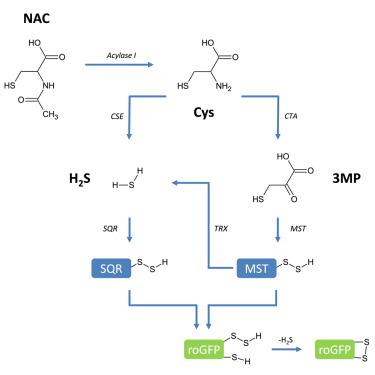当前位置:
X-MOL 学术
›
Cell Chem. Bio.
›
论文详情
Our official English website, www.x-mol.net, welcomes your
feedback! (Note: you will need to create a separate account there.)
N-Acetyl Cysteine Functions as a Fast-Acting Antioxidant by Triggering Intracellular H2S and Sulfane Sulfur Production
Cell Chemical Biology ( IF 6.6 ) Pub Date : 2018-02-08 , DOI: 10.1016/j.chembiol.2018.01.011 Daria Ezeriņa , Yoko Takano , Kenjiro Hanaoka , Yasuteru Urano , Tobias P. Dick
Cell Chemical Biology ( IF 6.6 ) Pub Date : 2018-02-08 , DOI: 10.1016/j.chembiol.2018.01.011 Daria Ezeriņa , Yoko Takano , Kenjiro Hanaoka , Yasuteru Urano , Tobias P. Dick

|
The cysteine prodrug N-acetyl cysteine (NAC) is widely used as a pharmacological antioxidant and cytoprotectant. It has been reported to lower endogenous oxidant levels and to protect cells against a wide range of pro-oxidative insults. As NAC itself is a poor scavenger of oxidants, the molecular mechanisms behind the antioxidative effects of NAC have remained uncertain. Here we show that NAC-derived cysteine is desulfurated to generate hydrogen sulfide, which in turn is oxidized to sulfane sulfur species, predominantly within mitochondria. We provide evidence suggesting the possibility that sulfane sulfur species produced by 3-mercaptopyruvate sulfurtransferase and sulfide:quinone oxidoreductase are the actual mediators of the immediate antioxidative and cytoprotective effects provided by NAC.
中文翻译:

N-乙酰半胱氨酸通过触发细胞内H2S和硫磺硫的产生而起速效抗氧化剂的作用
半胱氨酸前药N-乙酰半胱氨酸(NAC)被广泛用作药理抗氧化剂和细胞保护剂。据报道,它可以降低内源性氧化剂水平并保护细胞免受广泛的促氧化损伤。由于NAC本身对氧化剂的清除能力很差,因此NAC抗氧化作用背后的分子机制仍然不确定。在这里,我们显示了NAC衍生的半胱氨酸被脱硫生成硫化氢,而硫化氢又被氧化成亚砜硫,主要存在于线粒体内。我们提供的证据表明,3-巯基丙酮酸硫转移酶和硫化物:醌氧化还原酶产生的硫磺硫化物可能是NAC提供的直接抗氧化和细胞保护作用的实际介质。
更新日期:2018-04-19
中文翻译:

N-乙酰半胱氨酸通过触发细胞内H2S和硫磺硫的产生而起速效抗氧化剂的作用
半胱氨酸前药N-乙酰半胱氨酸(NAC)被广泛用作药理抗氧化剂和细胞保护剂。据报道,它可以降低内源性氧化剂水平并保护细胞免受广泛的促氧化损伤。由于NAC本身对氧化剂的清除能力很差,因此NAC抗氧化作用背后的分子机制仍然不确定。在这里,我们显示了NAC衍生的半胱氨酸被脱硫生成硫化氢,而硫化氢又被氧化成亚砜硫,主要存在于线粒体内。我们提供的证据表明,3-巯基丙酮酸硫转移酶和硫化物:醌氧化还原酶产生的硫磺硫化物可能是NAC提供的直接抗氧化和细胞保护作用的实际介质。











































 京公网安备 11010802027423号
京公网安备 11010802027423号